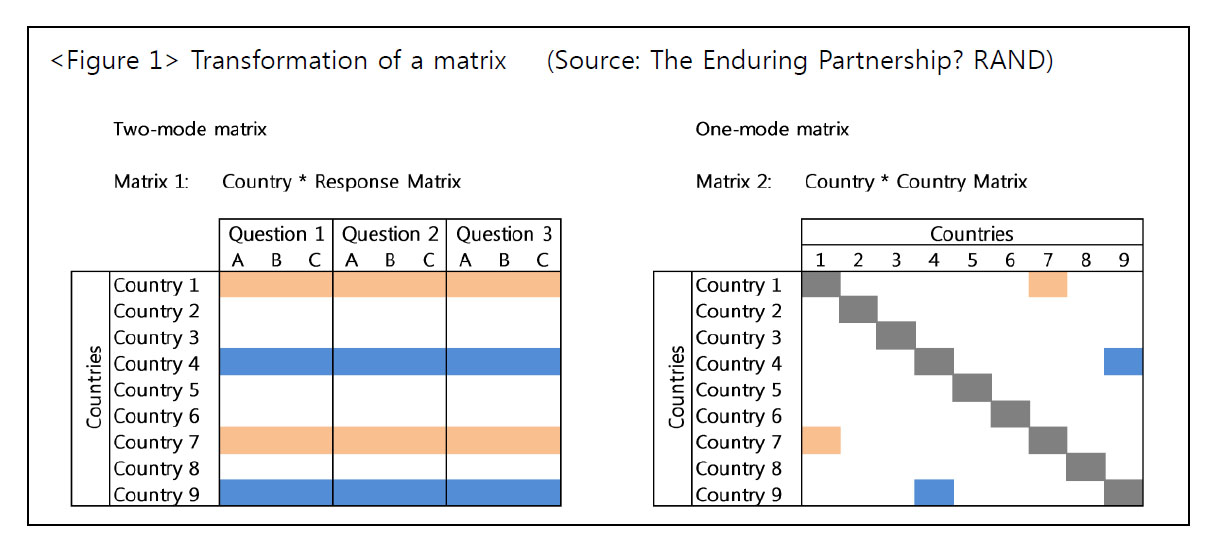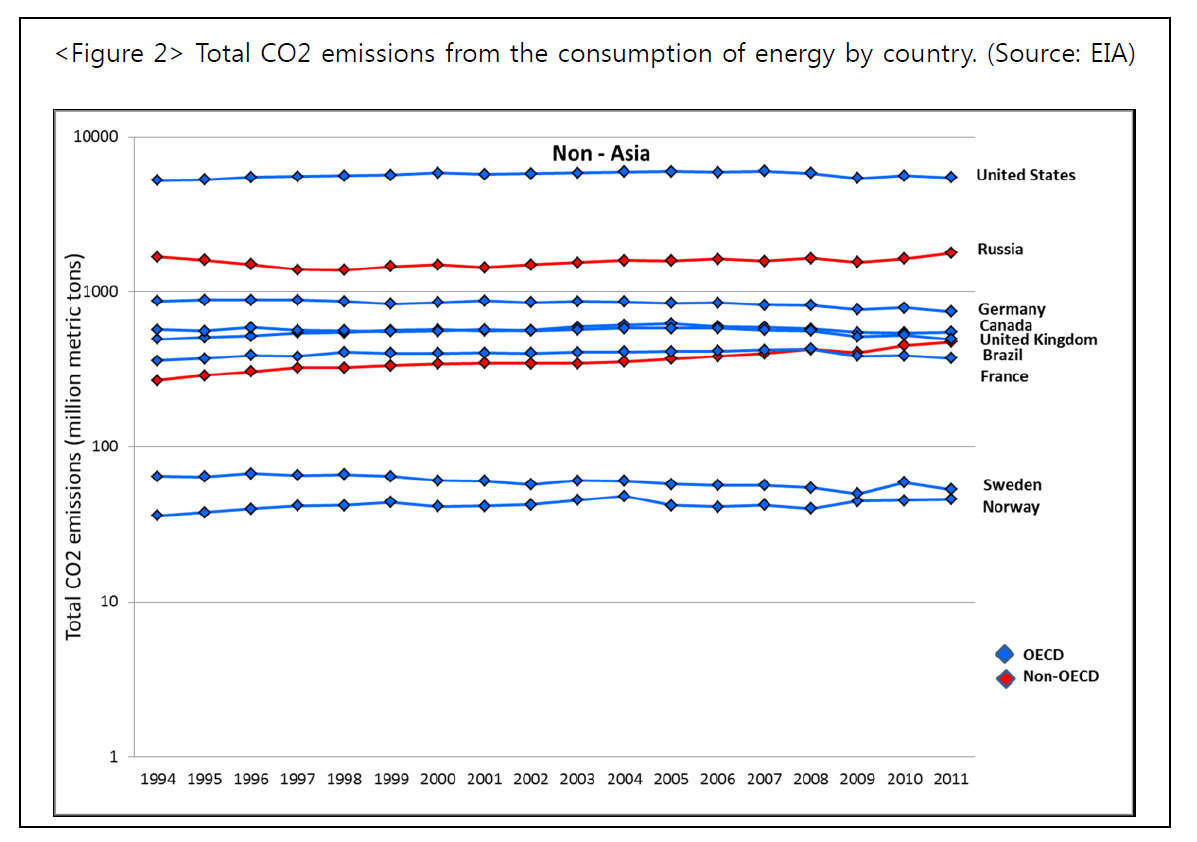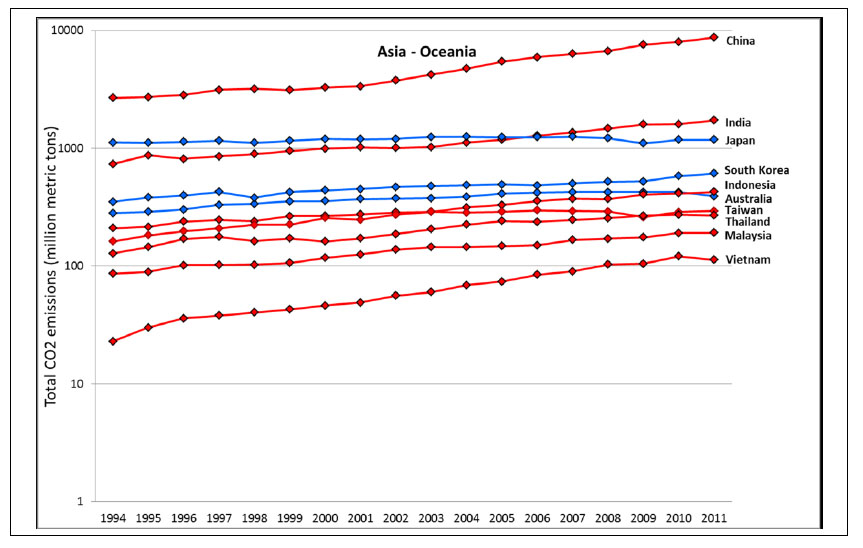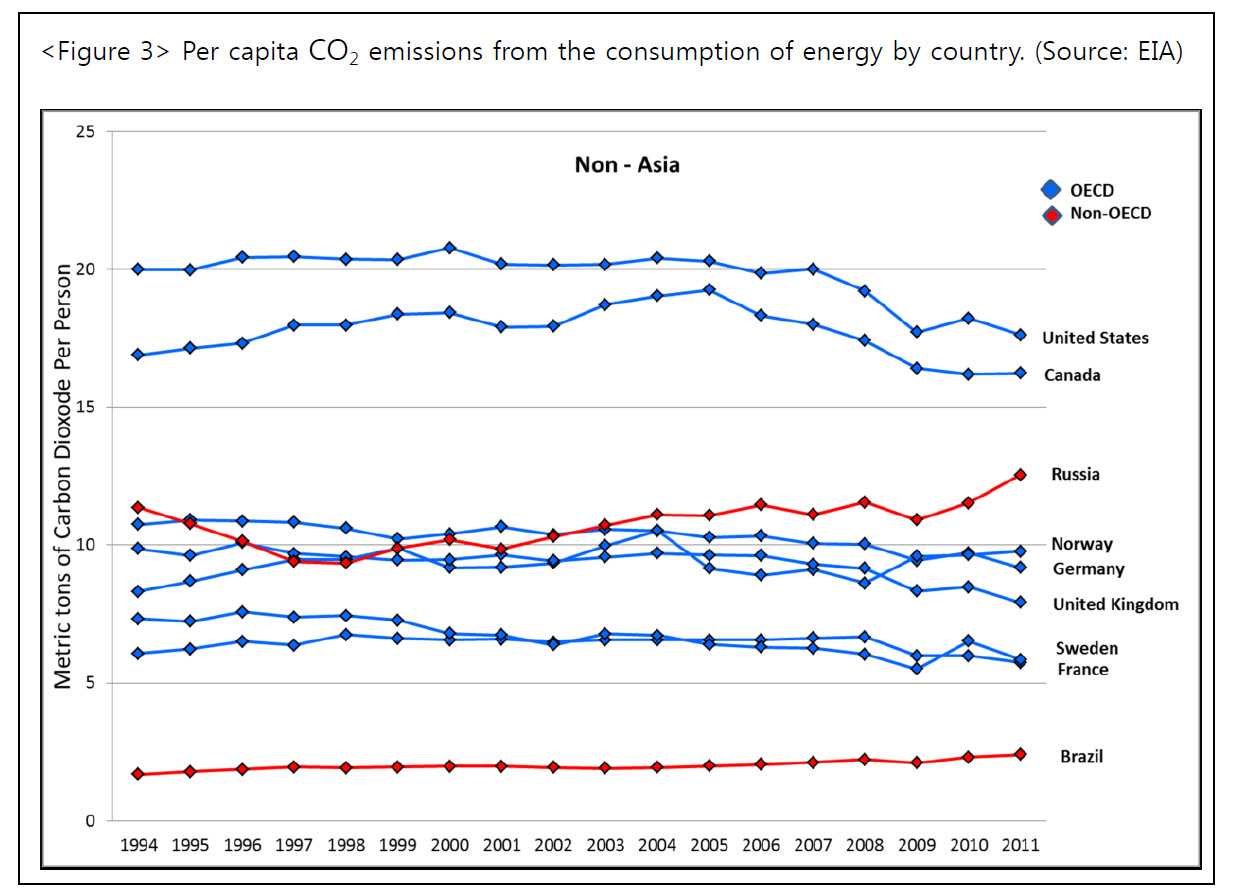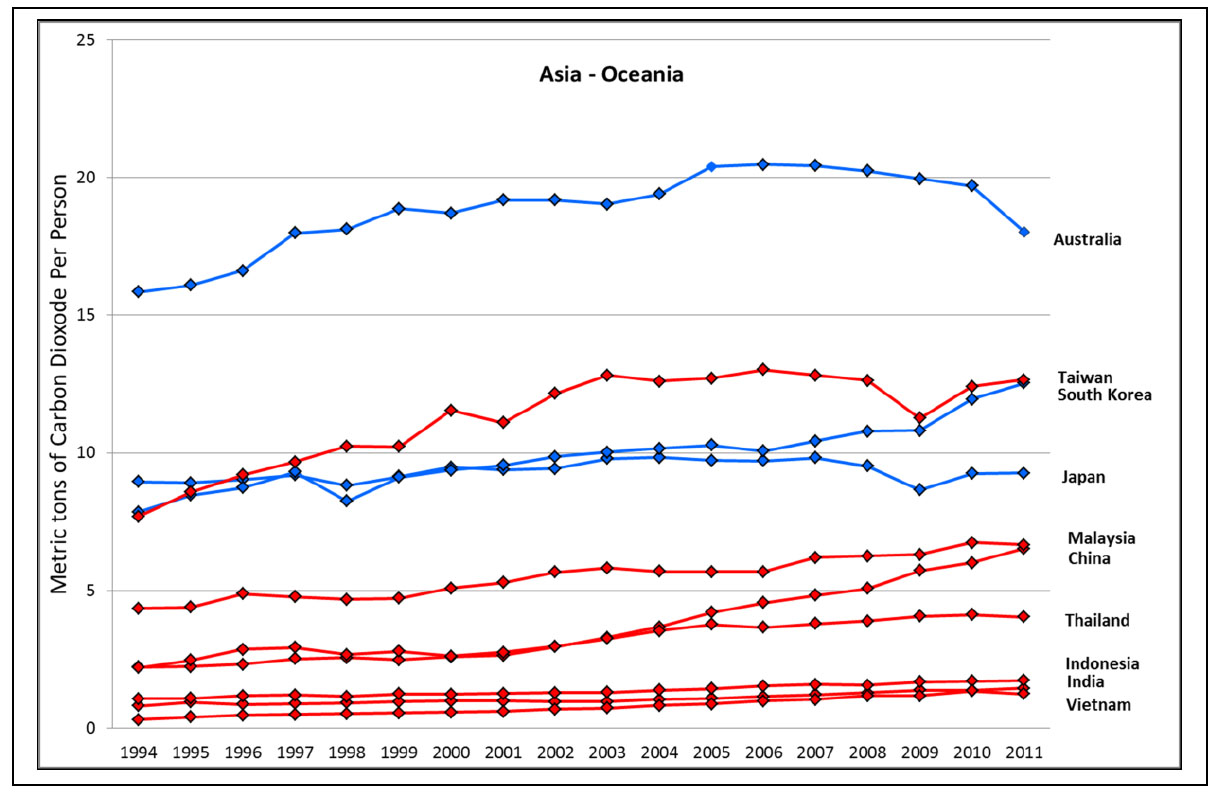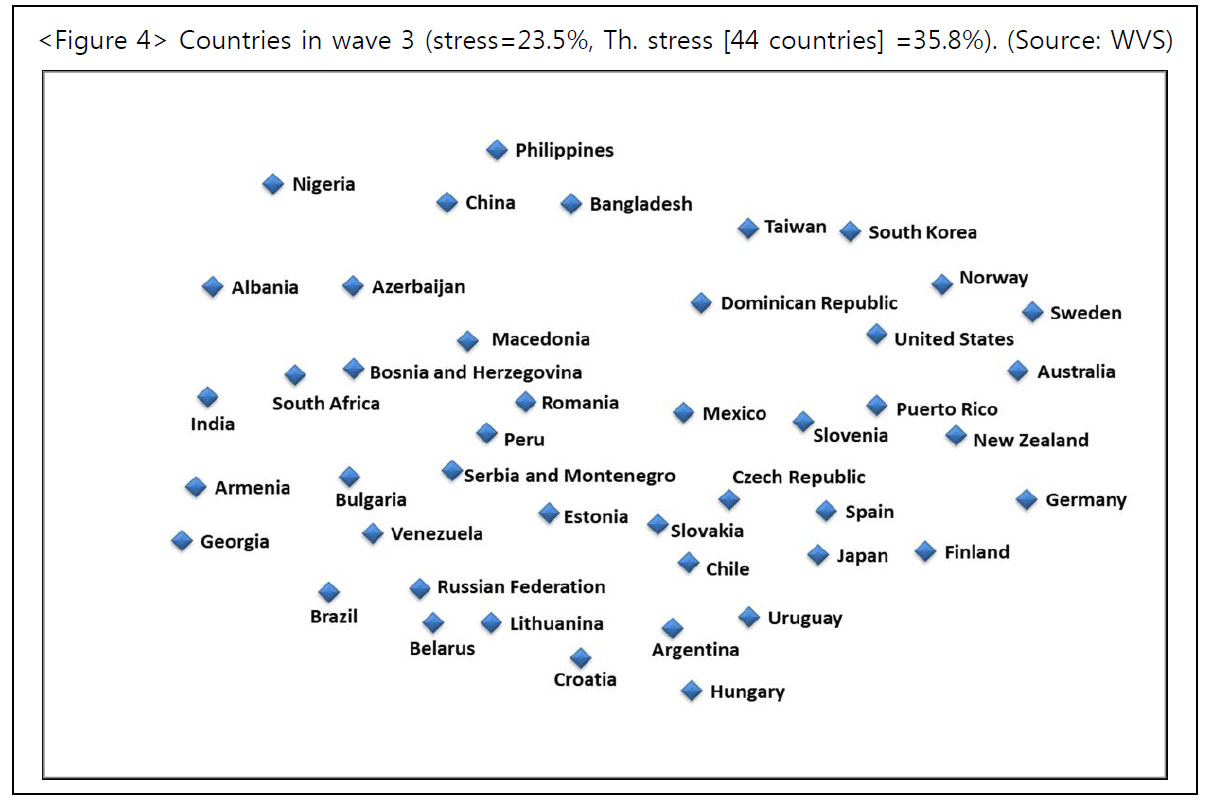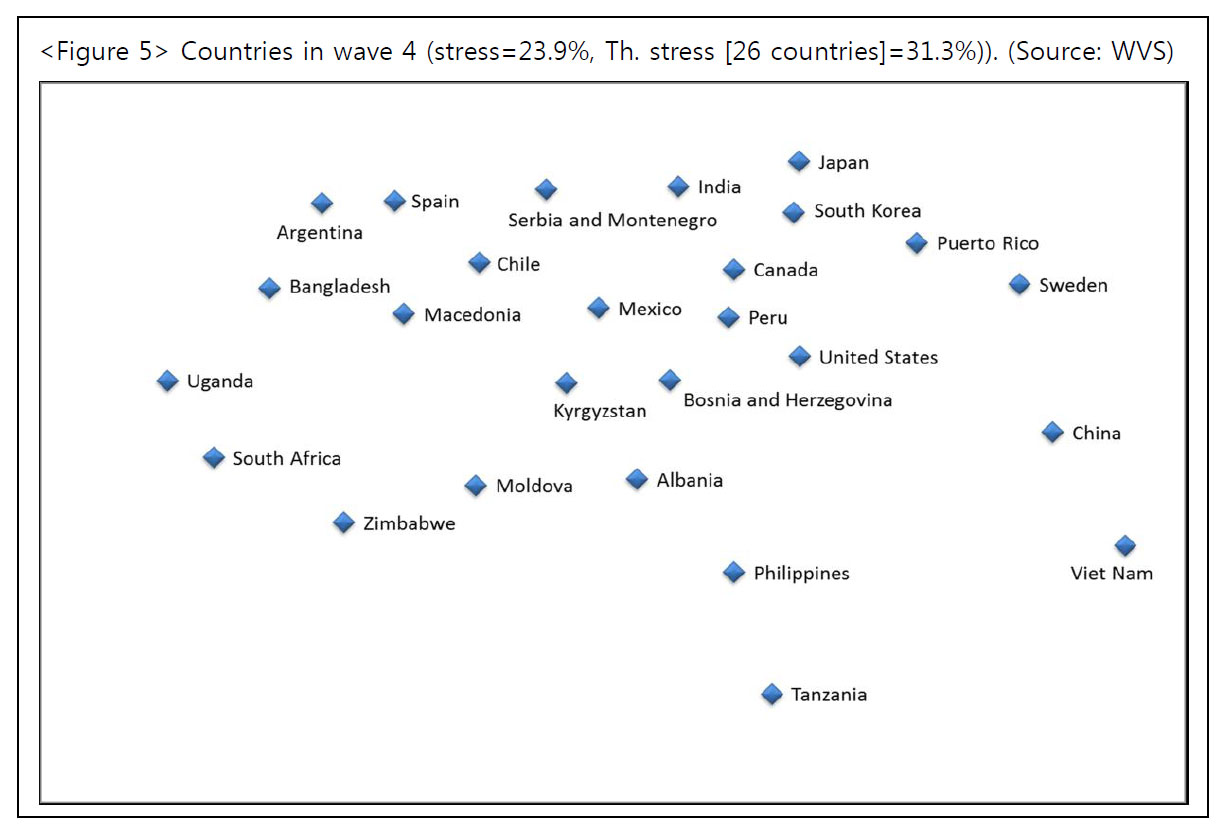The first “commitment period” of the Kyoto Protocol expired at the end of 2012 and it was agreed that the life of the Kyoto Protocol would be extended until 2020. The 2011 Durban platform was the first of its kind to include all countries including China and the United States in future negotiations to cut greenhouse gas emissions. Future negotiations will be even tougher and rockier than what we have witnessed so far. In this study, we have observed in simple diagrams, using the multi-dimensional scaling (MDS) technique, how similarly or differently people of many different countries responded at the aggregate level to the waves of surveys carried out by the World Values Survey (WVS) on environmental issues. Our findings show a wide-ranging view on the environment across countries. They also show which countries South Korea can partner with to find a solution to this complex problem. It is observed, by commonality, that South Korea can regionally cooperate with countries like Thailand, Malaysia, Japan, Taiwan, and to a lesser extent with China and Vietnam. Countries like the United States, Canada, New Zealand, Sweden, Norway, and Mexico can be South Korea’s non-regional partners.
Introduction
South Korea adopted green growth as a national development strategy during the former Lee Myung-bak government. The former President’s Committee on Green Growth stated, “As a responsible member of the global village, we have an obligation to work together in order to fight climate change, and take action to make sustained prosperity on Earth possible, not only for the current generation, but also for generations to come.”1 As a middle power, South Korea is committed to playing a bridging role between developed and developing countries to resolve difficult environmental issues. But it cannot fulfill this role on its own, and needs to work with other countries that are like-minded. By measuring how people of different countries responded to three waves of surveys by the WVS on the environment, regional and non-regional countries can be identified that South Korea can partner with on the environment. These countries share greater commonality with South Korea and their policymakers, reflecting people’s views, are likely to have an affinity with South Korean counterparts. This modeling technique based on MDS was first introduced by Ghez in his research into the Trans-Atlantic Alliance2.
Climate Change: Overview
The economic crisis of 2008 has pushed the problem of global warming off the list of priorities to be dealt with by the international community. The opening up of a sea passage through the Arctic Ocean would have triggered a lot of anxiety in the past but instead it has led to a great deal of enthusiasm given the economic benefits. Surely, we should be more concerned about this development. Isn’t this another piece of ominous evidence of global warming in progress? According to NASA, 2012 was the ninth warmest year during the 132-year period on record and the nine warmest years have all occurred since 1998. A joint effort to tackle global warming can be traced back to the United Nations Framework Convention on Climate Change (UNFCC), which is the first international climate treaty. It came into force in 1994 and has 195 signatories since 2011. The Kyoto Protocol was set up in 1997 to reduce global greenhouse gas by 5 percent of their 1990 levels by 2012. The countries were divided into developed and developing countries with only the former, the so-called Annex 1 countries, assuming obligations to cut their emissions. The two countries that mattered most—the United States and China—were absent from the scene. The United States didn’t take any part in this and China had no target set to limit its own emissions. With the ending of the first “commitment period” of the Kyoto Protocol at the end of 2012 and a series of United Nations Climate Change Conferences, it was agreed to extend the life of the Kyoto Protocol to 2020. The 2011 Durban platform was the first of its kind in that it encompasses all countries, including China, India, and the United States. The focus is now on developing and implementing a replacement to the Kyoto Protocol by 2015 and 2020, respectively. The total emissions from countries with Kyoto targets have significantly reduced, but emissions from developing countries have increased sharply. The first period of the Kyoto Protocol failed to curb global greenhouse gas emissions.3 Man-made CO2 has been accumulating since the industrial revolution and reached 393 PPM (parts per million)4 in September 2013. This is well beyond 350 PPM, considered by scientists to be the safe level. To follow up on the history and latest developments on global warming, the UNFCC is an excellent source of information5.
The work of John Tyndall shows that CO2 is a greenhouse gas that heats up the Earth, and Wallace Broecker, a renowned climate scientist, has likened the climate system as an angry beast that we are poking with sticks. Humanity only has limited time, if it is not too late already, to avert disastrous consequences on a scale never before seen. Yet, our goal towards a comprehensive agreement to effectively cut greenhouse gas emissions to the level recommended by scientists has not been met, and our progress is ever so slow due to many countries’ conflicting interests. The MDS technique has been instrumental in our research to shed some light on the situation. It is briefly described in the next section. Currently, there are datasets available for five waves of WVS project surveys from 1981 to 2007. Here we examined waves three to five, which correspond to the period from 1994 to 2007. Approximately 1,000 respondents took part in each country.
Methodology
The multi-dimensional scaling technique can be used to determine those countries whose people hold similar values or share commonality at the aggregate level (i.e., when treating each survey as a whole). In our research, we have used parts of a full dataset provided by the WVS on the environment (see the Appendix for the questionnaire)6. First, we take a two-mode, country-by-response matrix for each wave of surveys as shown in Figure 1.
In order to do a comparison between countries this two-mode matrix must be transformed into a one-mode matrix. Each cell in this one-mode, country-by-country similarity matrix has number representing correlation between two countries. So, for example, how similar or different responses are between countries four and nine will be represented by correlation in the country-by-country matrix in the cell shaded in blue. This one-mode matrix is converted into a diagram using the MDS technique. This diagram shows whether some countries tend to form a cluster or position themselves close to each other when the data is considered in aggregate. Clustering or close proximity means that these countries can potentially become collaborative partners. Only the distance between any two countries is meaningful, rather than country locations in the graph relative to the two axes. To put it simply, one can regard the distance as being inversely proportional to correlation. So, two highly correlated countries will appear close to each other, whereas two poorly correlated countries will appear distant from each other. There will also be a level of stress associated when displaying the diagram. A study by Sturrock and Rocha provides a way of assessing the impact of the stress accounting for both the number of dimensions (two in our case) and the number of objects (countries) represented in the diagram.7 They provide a table with a threshold stress (Th. stress) above which the probability that the objects are arranged randomly in the plot is greater than 1 percent. We have adopted this approach and in all our cases they are found to be below 1 percent. Mathematically, positioning the countries with as little stress as possible is equivalent to minimizing the target function below:
All analyses including the stress test were done using the UciNet software.8 For a detailed explanation of the methodology, please refer to the works of Ghez.
Carbon Dioxide Emissions
In global warming, we can broadly split the world into two sets of countries, developed and developing countries. Developed countries are mainly responsible for greenhouse gas emissions to date since the dawn of the industrial revolution, but it is the developing countries such as China which will play a crucial role in the future. In 2004, the combined emissions of developing and least developed countries accounted for about a quarter of cumulative emissions since the mid-eighteenth century.9 But China has already become the largest emitter of CO2 gas in the world. Russia, India, and Brazil with their growing economies are expected to follow suit. According to data provided by the US Energy Information Administration (See Fig. 2), China overtook the United States in 2006 as the world’s biggest CO2 emitter and produced 8,715 million metric tons of CO2 in 2011.10
Please note that a logarithmic scale is used for the y-axis so that countries considered can all be displayed clearly in Fig. 2. The US and South Korea produced 5,491 and 611 million metric tons of CO2 in the same year, respectively. One can also see that India’s output of 1,726 million metric tons of CO2 has surpassed that of Japan, the third largest economy in the world. Japan’s share of CO2 emissions is expected to increase with more fossil-fuel based power plants replacing the existing nuclear power plants after the Fukushima accident. Germany has been making efforts to moth-ball all nuclear power plants, which has pushed up their electricity prices. Although China is the biggest CO2 emitter in terms of total emissions, Australia, Canada, and the United States rank among the top 5 countries in the OECD in terms of per capita CO2 emissions (see Fig. 3).
Australia and Canada’s economies much depend on exporting raw materials such as coal to China, which increases per capita CO2 emissions. Unlike the total emissions, China ranks only at a similar level as that of Malaysia, which is well below Germany or the United Kingdom. South Korea is also responsible for emitting rather high CO2 emissions per capita with each person producing 12.5 metric tons of CO2. This is due to South Korea’s dependence on heavy industries such as steel, oil refineries, and chemicals. It must curb its own per capita CO2 emissions significantly to improve the country’s credibility on being serious about protecting the environment.
WVS – Wave 3 (1994~1999)
Questions: B002, B004, B008, B009, B010, B011, B012, B013, B014, B015, B016, B017
In this wave, there were questions about whether respondents had actually taken a small step to help protect the environment in the past. For example, on one question about whether respondents had chosen household products that were better for the environment, 73 percent of South Korean respondents said yes. They also responded positively to questions on recycling and reducing water consumption. Chinese respondents were roughly split in half on these questions. The survey took one step further by asking respondents if they had attended a meeting or contributed to an organization for an environmental cause. Both countries scored low on these questions. Nearly 90 percent of Chinese respondents indicated that humanity had a bright future compared to South Korea’s less optimistic 66 percent. The majority of South Koreans thought that human beings should coexist with nature. Brazil had 47 percent of its people choosing “economic growth and creating jobs” over “protecting the environment,” which was higher than China’s 29 percent. The majority of Brazilians, about 95 percent, believed human beings must coexist with nature, whereas the figure was 59 percent in China. Brazilians, like Chinese, held a view that environmental problems could be solved without any international agreements, and they were also observed to be less willing to take a small step such as choosing household products that were better for the environment. In India, 63 percent of respondents chose “economic growth and creating jobs” over “protecting the environment” and nearly 80 percent indicated that human beings should coexist with nature.
A mixture of Eastern European and Latin American countries occupies a mid-to-lower part of the MDS diagram. Among German respondents, 88 percent chose household products that were better for the environment, but 74 percent held a rather pessimistic view regarding humanity facing a bleak future. One can see that Western European countries are positioned towards the right, together with the United States, Australia and New Zealand. South Korea is in the vicinity of this formation near Norway, the United States, and Taiwan.
WVS – Wave 4 (1999~2004)
Questions: B001, B002, B003, B008, B009
In this wave, only five questions were asked to respondents in the countries shown in Figure 5. From this limited set of questions one should take care not to draw a firm conclusion. Three questions were repeated from wave three. We looked at China and found that a 10 percent shift was the largest we observed among the questions that were repeated, with more Chinese disagreeing with an increase in taxes to prevent environmental pollution. We could say that the Chinese attitudes did not change much over this time-period as far as those questions are concerned. China’s overall position changed in wave four compared to wave three.
More than 90 percent of South Koreans and Japanese believed that human beings should coexist with nature. Japan’s position in proximity to that of South Korea indicates greater commonality. Among respondents in the Philippines and Tanzania, 64 percent and 62 percent, respectively, indicated that protecting the environment should be given priority over economic growth. These figures are very high for developing countries. For South Africa, 39 percent of its people strongly agreed that the government should reduce environmental pollution without costing them any money. The figures were 18 percent for South Korea and five percent for China. Also, 62 percent of South Africans chose “economic growth and creating jobs” as the top priority over “protecting the environment.” The figures were 36 percent for South Korea and 32 percent for China. Most European countries were not included in this wave of the survey.
WVS – Wave 5 (2005~2007)
Questions: B001, B002, B003, B008, B018, B019, B020, B021, B022, B023
In this most recent wave, 10 questions out of 20 were retained so that direct comparisons could be made between the countries within the same wave. This was necessary because in some countries certain questions were not administered. Once again, a new set of questions was included in this latest survey. There were three questions about environmental problems in a respondent’s own community such as water, air quality, sewage, and sanitation. Another three questions considered large-scale environmental problems such as global warming, loss of biodiversity, and water pollution.
For those questions where direct comparisons could be made with the earlier wave four, South Koreans had further moved away from choosing “protecting the environment” in favor of “economic growth and creating jobs” by as much as an extra 16 percent. In wave three, carried out in 1996, the percentage of people who chose “protecting the environment” was at 70 percent but it was nearly halved to 36 percent in 2005. It must have been difficult for South Koreans to think of environmental issues before economic growth as making one’s living became increasingly difficult in the aftermath of the IMF-South Korea bailout in 1997. Among the questions that were repeated from wave four, there wasn’t a noticeable shift in Chinese people’s views. For the questions concerning the environmental problems in one’s own community, many South Koreans made a choice between “somewhat serious” and “not very serious” whereas, for many Chinese people, the choice was between “not very serious” and “not serious at all.” This is a little surprising considering all of the pollution problems facing China.
Let us consider Sweden. The country consistently ranked near the top, if not at the top, for providing clean water, good air quality, and proper sewage and sanitation. Swedish people cared about the environmental problems in the world, such as global warming, loss of diversity, and pollution of rivers, with more than 90 percent choosing either “very serious” or “somewhat serious.” For developed countries like the United States and Australia, the environmental problems facing a respondent’s own community were observed to be high with 30-40 percent choosing the option “very serious.” The US government must take this on board before taking full advantage of shale gas exploration. In Africa, we find Egyptians did not like the idea of increasing taxes to prevent environmental pollution, and yet believed the government should reduce environmental pollution without costing them any money. Over 90 percent of Egyptian respondents thought that the environmental problems in their community were very serious. It seems that the Egyptian government found itself with a difficult task of resolving environmental problems without costing taxpayers too much. There appears to be a cluster on the left consisting of countries from East Europe, Africa, the Middle East, and Latin America. For this particular wave, South Korea shared greater commonality with countries in its region. Taiwan is again very close to South Korea.
Conclusion
Global warming is humanity’s greatest threat. The Stern Review on the Economics of Climate Change lists possible impacts climate change could have on people around the world.11 An average global temperature rise of two-to-three degrees Celsius will lead to serious consequences such as declining crop yields and rising sea levels. Hundreds of millions of people will face difficulty producing or purchasing sufficient food in Africa. Some countries in South East Asia like Bangladesh, Vietnam, and large coastal cities such as Tokyo, Shanghai, Hong Kong, Mumbai, New York, Miami, and London will need to strengthen their coastal protection. Melting glaciers during dry-season will reduce water supplies to one-sixth of the world’s population in the Indian subcontinent, parts of China, and the Andes in South America.
Figures 4-6 provide us with snapshots of how difficult it would be for all countries in the world to commit themselves to cutting greenhouse gas emissions under a legally binding treaty. They show a wide range of opinions in people’s views regarding the environment across many countries. However, it is observed that Western European countries, New Zealand and Australia, Canada and, to some extent, the United States were in each other’s vicinity. Recall that the United States, Canada, and Australia, three countries with high per capita CO2 emissions, are observed to be near each other in all three waves. Some ASEAN countries and perhaps Japan responded similarly in some surveys. Countries grouped broadly by region can potentially cooperate in future negotiations. These can perhaps act as initial building blocks if all the countries in the world cannot come to comprehensive international agreements. A piecemeal type approach could be adopted towards the ultimate goal of achieving these international agreements if all else leads to impasse. It is interesting to note that Bueno de Mesquita, a renowned game theorist, paints a pessimistic picture on the likelihood of curbing CO2 emissions at the expense of sacrificing economic growth12.
South Koreans’ responses are found to be similar to those in the West when it comes to its people taking a small step to saving the environment. However, the recent wave five shows that we also share much commonality with many countries in this region in our attitudes toward environmental issues. On the one hand, most developed countries such as Sweden and Norway portray a view that their country’s environmental problems cannot be solved without any international agreements but, on the other hand, developing countries such as China and Brazil think they can solve their own environmental problems without any international agreements.
South Korea, as a middle power, is perfectly suited to act as an intermediary between developed and developing countries. In 2012, the South Korean government, the first in Asia, introduced a law, the Act on the Allocation and Trading of Greenhouse Gas Emission Permits, establishing a cap-and-trade system for emissions. It aims to reduce greenhouse gas emissions by 30 percent by 2020, which will enter into force in 2015. Also, Songdo, Incheon in South Korea became the host city of the Green Climate Fund (GCF) in 2012.13 The GCF must first have sufficient funds to meet its obligations. There will be a tug of war between developed and developing countries on who will contribute the funds and how the funds are to be used. Developed countries must not renege on their financial pledges and developing countries must be able to provide evidence that the funds are properly applied. Sir David King, former UK Chief Scientific Advisor, discusses ways money can be channeled from developed countries to developing countries for mutual benefit, and also explains their pros and cons.14 Finally, the Global Green Growth Institute was established in Seoul to help countries around the world adopt green growth strategies15.
To quote the IPCC’s Fourth Assessment Report, “all of Asia is very likely to warm during this century, the warming is likely to be well above the global mean in central Asia, the Tibetan Plateau and northern Asia, above the global mean in East and South Asia, and similar to the global mean in Southeast Asia. It is very likely that summer heat waves/hot spells in East Asia will be of longer duration, more intense, and more frequent…”16 This region is predicted to be hit harder by global warming, as already witnessed by the super-typhoon that hit the Philippines, and needs a coordinated approach. To this end, South Korea can work together with regional partners such as Thailand, Malaysia, Japan, Taiwan, and also perhaps, to a lesser extent, China and Vietnam. It is imperative that South Korea, Japan, and China address China’s growing smog problem as it is expected to get worse and become more frequent. The problem is already reaching a crisis level in mainland China. Developed countries like the United States, Canada, New Zealand, Sweden, and Norway can be our non-regional partners. Mexico is another middle power South Korea can collaborate with. Countries such as the United Kingdom and Denmark that were left out from the surveys can be included in this group of non-regional partners.17 These findings strengthen the case for South Korea to act as the responsible intermediary bridging the gap between developed and developing countries on environmental issues.
* I would like to thank Dr. Federico Gallo at Believe Green organization in Chicago and Professor Jeremy Ghez at HEC, Paris for providing useful comments.
Appendix (* is only included in wave 2)
B001. Would give part of my income for the environment:
1: Strongly agree, 2: Agree, 3: Disagree, 4: Strongly disagree
B002. Agree to an Increase in taxes if used to prevent environmental pollution
1: Strongly agree, 2: Agree, 3: Disagree, 4: Strongly disagree
B003. Government should reduce environmental pollution, but it should not cost me any money
1: Strongly agree, 2: Agree, 3: Disagree, 4: Strongly disagree
B004. I would buy things at a 20% higher price if it helped to protect the environment
1: Strongly agree, 2: Agree, 3: Disagree, 4: Strongly disagree
B005. All talk about the environment make people anxious *
1: Strongly agree, 2: Agree, 3: Disagree, 4: Strongly disagree
B006. If we want to combat unemployment in this country, we shall just have to accept environmental problems *
1: Strongly agree, 2: Agree, 3: Disagree, 4: Strongly disagree
B007. Protecting environment and fighting pollution is less urgent than suggested *
1: Strongly agree, 2: Agree, 3: Disagree, 4: Strongly disagree
B008. Which one comes closer to your own point of view?
1: Protecting environment, 2. Economy growth and creating jobs, 3. Other answer
B009. Which one comes closer to your own point of view?
1: Human beings should master nature, 2. Human beings should coexist with nature, 3: Both, 4: Neither, 5: Other answer
B010. [COUNTRY]’s environmental problems can be solved without any international agreements to handle them.
1: Strongly agree, 2: Agree, 3: Disagree, 4: Strongly disagree
Which, if any, of these things have you done in the last 12 months, out of concern for the environment? Have you decided for environmental reasons to reuse or recycle something rather than throw it away? (B011-B015)
B011: Have you chosen household products that you think are better for the environment?
0: Have not, 1: Have done
B012. Have you decided for environmental reasons to reuse or recycle something rather than throw it away?
0: Have not, 1: Have done
B013. Have you tried to reduce water consumption for environmental reasons?
0: Have not, 1: Have done
B014. Have you attended a meeting or signed a letter or petition aimed at protecting the environment?
0: Have not, 1: Have done
B015. Have you contributed to an environmental organization?
0: Have not, 1: Have done
B016. Which one should we emphasize more?
1: Tradition, 2: High economic growth, 3: Both, 4: Neither, 5: Other
B017. Which one comes closest to your own views?
1: Humanity has a bright future, 2: Humanity has a bleak future, 3: Both, 4: Neither, 5: Other
B018. Environmental problems in your community: Poor water quality.
1: Very serious, 2: Somewhat serious, 3: Not very serious, 4: Not serious at all
B019. Environmental problems in your community: Poor air quality.
1: Very serious, 2: Somewhat serious, 3: Not very serious, 4: Not serious at all
B020. Environmental problems in your community: Poor sewage and sanitation
1: Very serious, 2: Somewhat serious, 3: Not very serious, 4: Not serious at all
B021. Environmental problems in the world: Global warming or the greenhouse effect.
1: Very serious, 2: Somewhat serious, 3: Not very serious, 4: Not serious at all
B022. Environmental problems in the world: Loss of plant or animal species or biodiversity.
1: Very serious, 2: Somewhat serious, 3: Not very serious, 4: Not serious at all
B023. Environmental problems in the world: Pollution of rivers, lakes and oceans.
1: Very serious, 2: Somewhat serious, 3: Not very serious, 4: Not serious at all
The views expressed herein do not necessarily reflect the views of the Asan Institute for Policy Studies.
- 1
The World Bank, “Korea’s Global Commitment to Green Growth,” May 3, 2012, http://www.worldbank.org/en/news/feature/2012/05/09/Korea-s-Global-Commitment-to-Green-Growth.
- 2
Ghez, Jeremy, The Enduring Partnership? The Trans-Atlantic Community as a Natural Alliance (Santa Monica: RAND Corporation, 2010), http://www.rand.org/content/dam/rand/pubs/rgs_dissertations/2010/RAND_RGSD266.pdf.
- 3
“Has the Kyoto protocol made any difference to carbon emissions?” The Guardian, November 26, 2012, http://www.theguardian.com/environment/blog/2012/nov/26/kyoto-protocol-carbon-emissions.
- 4
CO2Now.org, http://co2now.org/.
- 5
United Nations Framework Convention on Climate Change, http://www.theguardian.com/environment/blog/2012/nov/26/kyoto-protocol-carbon-emissions.
- 6
The World Values Survey: http://www.worldvaluessurvey.org/index_html.
- 7
Kenneth Sturrock and Jorge Rocha, “A Multidimensional Scaling Stress Evaluation Table,” Field Methods 12, no. 1 (2000): 49-60.
- 8
Stephen P. Borgatti, Martin G. Everett, and Jeffrey C. Johnson, Analyzing Social Networks (Los Angeles: Sage Publications Ltd., 2013).
- 9
Michael R Rapauch et al., “Global and Regional Drivers of Accelerating CO2,” Proceedings of the National Academy of Sciences of the United States of America 104, no. 24 (2007): 10288-93.
- 10
The US Energy Information Administration, http://www.eia.gov/.
- 11
Nicholas Stern, “Chapter 3: How Climate Change will Affect People Around the World,” in The Stern Review on the Economics of Climate Change (Cambridge: Cambridge University Press, 2006).
- 12
Bruce Bueno de Mesquita, The Predictioneer’s Game: Using the Logic of Brazen Self-Interest to See and Shape the Future (New York: Random House Trade Paperbacks, 2010).
- 13
Green Climate Fund, http://gcfund.net/secretariat/host-city-songdo.html.
- 14
David King and Gabrielle Walker, The Hot Topic: How to Tackle Global Warming and Still Keep the Lights on (London: Bloomsbury Publishing PLC, 2008).
- 15
Green Climate Fund, http://gcfund.net/secretariat/host-city-songdo.html.
- 16
Susan Solomon et al., Climate Change 2007: The Physical Science Basis (Cambridge: Cambridge University Press, 2007).
- 17
Department of Energy & Climate Change, Foreign & Commonwealth Office, “United Kingdom – Republic of Korea joint statement on climate change,” November 7, 2013, https://www.gov.uk/government/news/united-kingdom-republic-of-korea-joint-statement-on-climate-change.

 Facebook
Facebook Twitter
Twitter